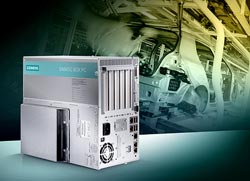Flexible, high-performance Box PC for machine-level use

The new device has almost double the processing power of its predecessor, and with five PCI/PCIe slots for expansion cards, it offers a high degree of flexibility. Simatic IPC827C is suitable for high-speed measuring, control and visualization tasks at the machine level. The rugged PC is designed for continuous 24-hour use as well as for high temperature, vibration, shock and EMC loads.
The new high-performance Simatic IPC827C Box PC processes high volumes of data especially quickly in demanding automation applications. For this purpose, it is equipped with a 2010 Intel Core i3 or i7 processor and DDR3 memory technology up to four gigabytes, optionally with integral ECC error correction. The improved onboard HD graphics with 3 to 5 times the performance power of the predecessor model enables high-speed visualization solutions. A powerful graphics card can be integrated for this purpose via a PCIe-x16 slot. Equipped with the latest Intel mobile technology, the Box PC is characterized by lower power consumption and high energy efficiency. The power supply unit with an efficiency level greater than 80 percent and the Wake-on-LAN functionality contribute to this. The version with the Core-i7 processor enables password-protected remote access by means of the Active Management Technology (AMT) from Intel. This allows authorized IT personnel to manage and maintain the Simatic IPC remotely and also correct faults.
Simatic IPC827C is installation-compatible and software-compatible with the predecessor model. It has the identical performance features as the already available Simatic IPC627C. For expansion purposes, the Simatic IPC627C offers two free PCI/PCIe slots, and the new Simatic IPC827C Box PC offers five. For setting up low-maintenance, hard-disk-free systems, the device has two Compact Flash Card slots that are easily accessible from outside, and one 32-gigabyte solid-state drive (SSD) in industrial single-level cell (SLC) architecture. The Box PC is suitable for a host of installation positions and mounting options, such as wall-mounting or portrait assembly. All the interfaces and function elements, such as the two “teaming”-capable Gigabit Ethernet ports and the four Hi-Speed USB 2.0 connections, are accessible from the front. A Raid1 controller and an optional Profibus or Profinet interface with 3-port IRT switch are integrated on the mainboard. Two freely programmable 7-segment displays and two signalling LEDs indicate the Bios power-up and enable fast diagnostics of the operating status, even within software applications. A Simatic flat-panel monitor can be connected from a distance of up to 30 meters via the integral DVI-I interface. A battery-backed 2-megabyte SRAM backs up critical data such as production control data in the event of an unexpected power failure.
The pre-installed and activated operating systems Windows Embedded Standard 2009, Windows 7 Ultimate and Windows XP Professional are optionally available. Like all Simatic PCs, the new Simatic IPC827C offers a high degree of investment security. It is available for up to five years in the identical form, and thereafter with spare parts availability for at least five years after declaration of product phase-out.
The Siemens Industry Sector (Erlangen, Germany) is the world's leading supplier of environmentally friendly production, transportation, building and lighting technologies. With integrated automation technologies and comprehensive industry-specific solutions, Siemens increases the productivity, efficiency and flexibility of its customers in the fields of industry and infrastructure. The Sector consists of six Divisions: Building Technologies, Drive Technologies, Industry Automation, Industry Solutions, Mobility and Osram. With around 207,000 employees worldwide Siemens Industry posted sales of about EUR35 billion in fiscal year 2009. http://www.siemens.com/industry
The Siemens Industry Automation Division (Nuremberg, Germany) is a global leader in the fields of automation systems, industrial controls and industrial software. Its portfolio ranges from standard products for the manufacturing and process industries to solutions for whole industrial sectors that encompass the automation of entire automobile production facilities and chemical plants. As a leading software supplier, Industry Automation optimizes the entire value added chain of manufacturers – from product design and development to production, sales and a wide range of maintenance services. With around 39,000 employees worldwide (September 30), Siemens Industry Automation achieved sales of €7.0 billion in fiscal year 2009. www.siemens.com/industryautomation
Reference Number: IIA2010112509e
Media Contact
More Information:
http://www.siemens.com/simatic-ipcAll latest news from the category: Machine Engineering
Machine engineering is one of Germany’s key industries. The importance of this segment has led to the creation of new university degree programs in fields such as production and logistics, process engineering, vehicle/automotive engineering, production engineering and aerospace engineering among others.
innovations-report offers informative reports and articles covering technologies such as automation, motion, power train, energy, conveyor, plastics, lightweight construction, logistics/warehousing, measurement systems, machine tools and control engineering.
Newest articles

Innovative 3D printed scaffolds offer new hope for bone healing
Researchers at the Institute for Bioengineering of Catalonia have developed novel 3D printed PLA-CaP scaffolds that promote blood vessel formation, ensuring better healing and regeneration of bone tissue. Bone is…

The surprising role of gut infection in Alzheimer’s disease
ASU- and Banner Alzheimer’s Institute-led study implicates link between a common virus and the disease, which travels from the gut to the brain and may be a target for antiviral…

Molecular gardening: New enzymes discovered for protein modification pruning
How deubiquitinases USP53 and USP54 cleave long polyubiquitin chains and how the former is linked to liver disease in children. Deubiquitinases (DUBs) are enzymes used by cells to trim protein…



